
Using the Phantom HD Camera
Posted on May 11, 2010 by Alex Fice
Jason Berman at Take 2 Films in London has some hard and fast rules when using the Phantom HD camera, but if you follow them you could be using one of the best HD cameras aroundThe Project that I worked on with DoP Harvey Glen was for new ‘idents’ for the channel Animal Planet part of the Discovery Channel. Various animals were used including a horse, elephant, Afghan hound, monkey, ostrich and meerkat. For the most part the Phantom was used at 1000fps to capture specific shots that are not necessarily high speed in action, but the fact that you can shoot at such speeds enabled us to capture these shots without a huge amount of time.
For example particular things you want an animal to do but they will never do it, well if you shoot at 25fps they never do what you want, but if you shoot at 1000fps they will do what you want and at that speed there’s enough action to get the shot you need. Some shots are clearly high speed, like a low and wide angle shot of a horse rearing up on to its hind legs. That may have been two seconds in real time, but shot at 1000fps the shot is amazing, one of the best I have ever used the camera for. Shot against a blue sky with clouds, it one of those shots that truly amazes any viewer and lasts about 11/2 minutes.
Nothing surprises me about the camera now. It’s the action that it can capture!
With 1000fps shots when you cut, if the director says ‘no good lets go again’, I always replay the active part of the shot back, just in case and more times than not, the directors says OK there is something in it, maybe not exactly what they wanted but there is something useable. I always explain to people that your eyes cannot see at 1000fps so always watch the shot no matter what your immediate reaction is after cutting,
I always ask any DoP to come and see me before shooting. This is the best way to have a successful shoot. My job is to guide people on how to shoot with the Phantom HD and although I deal with setting up the camera and maintaining the data through shooting, it is also my job to make sure that they use light correctly. This can often be a little tricky to tell DoPs on-set if I have never met or work with them before, this is why I like to meet them at Take 2 Films [www.take2films.co.uk] and take them through all the ins and outs of the camera and what my job is. The last thing I want to do is turn up on set with someone who I have not met and start telling them what to do with their lights. High speed digital cameras are inherently more ‘contrasty’ than normal speed digital cameras. They have a lower dynamic range, than normal speed high definition cameras. Phantom HD has one of the widest dynamic ranges of all high speed cameras, but to get the most out of it you need to be much more careful with how you light the subject so that it does not appear too ‘contrasty’.
 The Cinemag and it’s docking station called CinestationThere are a few ways to shoot with this camera. The best way is to adjust the gamma as little as possible during shooting. But the less you adjust the gamma the more ‘contrasty’ the images are, but with fill lighting you can lower the contrast of the shot, by using little or no gamma adjustment and by using fill lighting more you obtain the best and punchiest of images. Unfortunately most DoPs require some gamma adjustment, as time and the amount of lights at hand are often the limiting factor.
The Cinemag and it’s docking station called CinestationThere are a few ways to shoot with this camera. The best way is to adjust the gamma as little as possible during shooting. But the less you adjust the gamma the more ‘contrasty’ the images are, but with fill lighting you can lower the contrast of the shot, by using little or no gamma adjustment and by using fill lighting more you obtain the best and punchiest of images. Unfortunately most DoPs require some gamma adjustment, as time and the amount of lights at hand are often the limiting factor.
I explain how the camera works, how it reacts to light, and how to expose for raw files using the histogram. Most people are used to using waveforms now, but as this camera is mainly used to shoot raw files, raw files use the same way of exposing as digital stills cameras and you need to use a histogram to judge exposure accurately.
You do have an HD-SDI output giving you a close but not precise image of what you are shooting, this is more of a ‘video assist’ that you can judge your framing and focus accurately with. The HD-SDI is only used with a waveform if it is a rare live event or you’re are going to record directly to HDCAM SR on set (8-bit 4:2:2 maximum at the moment and is the last option in rushes output, but can be a good compromise if you do not need images above 1920 x 1080 and are not doing heavy special effects as the recording is only at 4:2:2 8-bit – I avoid this option as much as possible.)
The way you store data on set is often a little tricky for production and directors to get their head around.
With a Phantom HD 16GB and 256GB Cinemag at 1920×1080 the camera has approx 4300 (16GB) frames of which it can shot to. If you are shooting at 1000fps the camera will shoot for 4.3 (approx) seconds before it starts to shoot over itself.
At 100fps this is 43 seconds (this 4300 frames is about three minutes when you playback at 25fps).
So if you do a high speed shoot at 1000fps you need to get your action in within this 4.3 seconds and cut the camera, at this speed there is no time for indecisiveness, so to start off with the discussion of who will decide when to cut is very important.
So if you have your shot in the 16GB RAM of the camera after cutting, at this point if the power goes from the camera the shot will be lost.
Without the Cinemag you need to make a decision of whether you will save this shot now, if you save all 4300 frames it will take between 6-8 minutes (you can cut in and save only the active area of the shot average time 3-5 minutes), or shoot again immediately. If you shoot again immediately you will need to dump the shot in the 16GB of RAM, this shot once dumped is unrecoverable.
With the Cinemag, you can save the shot to the Cinemag and be shooting with ten seconds of cutting from the shot before. So you can be decisive of what you want to save at a later point in the day.
The Cinemag is 256GB of non-volatile RAM, and is very secure, it’s by far the safest place to keep any shots that are not downloaded. Most of the time I save all shots to the Cinemag automatically after cutting for safety and make a note of possible good takes after playback.
The Phantom HD shoots its own raw format files called ‘.cine’, these files need to be converted to a format that you can use in editing. Generally for high quality work the files re-converted to 16 bit tiffs, they can also be played out to 10-bit 4:4:4 HDCAM SR, using SpeedGrade EXR. We have passed as much conversion work as possible to a company called My Therapy [www.mytherapy.tv] as they have understood and worked out the best way to deal with Phantom HD files.
Unfortunately most large post houses are not set up for these new raw data shooting cameras and even though not difficult to do they struggle to deal with tiff conversion or real time play out to HDCAM SR, so a collaboration between My Therapy and Take 2 was needed to do get the Phantom HD working as we wanted.
The above process is a bit like a one light telecine or a best light telecine and the whole shooting process including exposing for your raw file and over night conversions is much more like film than like high definition.
So the more footage you download from the Camera/Cinemag, the more it will cost production to develop/convert. This is why it is best to be as decisive as possible during the download stage. I will always encourage directors to be as frugal as possible with what they are going to save and be as tight with their ‘cut ins’ and ‘cut outs’ when I work with them on downloading shots. On some productions this is not a problem and they want everything, this is fine but data can start to mount up to very large amounts very quickly.
It is very important for me to explain these processes to production as soon as the job gets booked so they can budget correctly, and understand how they need to work with this camera, and make sure it is suitable for their job. Average shooting amounts are between 300-500GB a day for high speed stuff. You can easily shoot double this if you are using the Phantom as a normal speed camera and some very specific high speed shots can shoot as little as 60–80 GB a day for five takes on an explosion or something like that. It really depends on many things.
I get asked one question regularly. How much will we shoot? (difficult question, things change a lot). Because of the data involved, during the course of the day quite a few backups have to be done. So by the end of my shooting day, there could be up to four copies of what has been shot during the day. One copy on the Cinemag, one copy on RAID capture drive, one copy on a back-up drive and one copy on client’s rushes delivery drive.
The camera shoots 14-bit depth images at 4:4:4 compression on to single chip CMOS Super 35 sized sensor at 1920×1080 (chip is bigger than super 35 at 2K 16×9). These specs eclipse most other 24/25/30fps high definition cameras.
Panavision Genesis and Arri D21 cameras, I believe, are the only real contenders and they are normal speed cameras that can over and under crank a little. But not 4fps to 1050 at 1920×1080 that the Phantom HD can shoot. The raw file is major advantage as it holds a huge amount of latitude that can be extracted during post. The only drawback would be the downloading of data and conversion of files. Recently I have worked on two music promos using the whole square chip 2048×2048 using anamorphic lenses at 2:1 ratio, the converted images are outstanding, the resolution is almost double that of 1920×1080.
As for lighting for the Phantom, during Harvey Glen’s Discovery Channel shoot we used mainly Tungsten 20ks, 12ks, 10ks and 5ks. These lights are the best lights to use as all high speed cameras can capture flicker from not using the right lights.
I have tested a lot of lights mainly with the help of David Morphy at Cirrolight and he has lots of interesting lights that you can use, not all should work, but do. The basic rule is Long Strikes, Luminys, Vistabeams and Tungsten bigger than 5k,
I believe the right working ASA for the Phantom HD at 25fps, 180 degree shutter, is 320 for Tungsten and 160 for Daylight
It is clearly the best high speed digital camera out there currently and I would use it for what it was designed for anything that has the high speed element. Sports, Action, Commercials. Vision Research, who make the Phantom are constantly bringing out upgrades for the camera and you can send your camera back at any time for them. We have had our cameras for about four months and both are in the process of being upgraded, this improves image quality and ease of use.
It is difficult to say where the camera stands compared to other digital models as it does not really have any similar contenders. Please tell me what other camera has 14-bit 4:4:4 35mm sized PL mounted recording at 25fps let at alone 1000fps.
We had two Phantom HDs next to a Genesis on a shoot recently, and even though what you see on the HD-SDI monitors is really a ‘Video Assist’ of both Phantom HD and Genesis, the Phantom HD video assist was clearly the better one. Who knows what they would be like under proper tests with Phantom HD/ Genesis / D21 / F35 / RED. I would love to really see, but not sure if this will happen, or if it does not sure if we would ever know the truth.
But as far as high speed cameras, there is only really two choices now, Photosonics and Phantom HD, both have advantages and disadvantages over each other.








